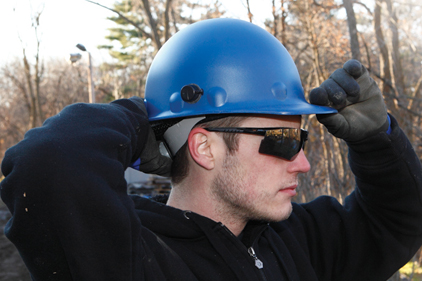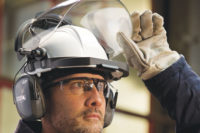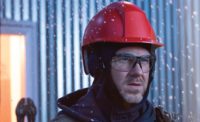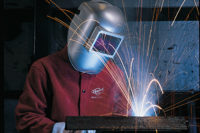According to the BLS, in 2008 there were 27,450 eye injuries, accounting for 62 percent of face injuries and 37 percent of all head injuries requiring days away from work. BLS data also shows that construction workers have the second highest rate of workplace eye and face injuries in the country, and that men comprise the majority of eye injury cases at a whopping 81 percent. Considering that more than 90 percent of eye and face injuries are avoidable by using proper eye and face protection, there is much room for greater and improved use of these products.
Determining how to provide the right combination of head and face protection can be a confusing task. This article discusses what to look for when selecting combined head, eye and face protection for workers in multi-hazard environments.
Selecting eye and face protection
Workers exposed to chemicals, flying objects, high particulate matter and even excessive dust require eye protection. All safety eyewear must comply with the American National Standards Institute’s ANSI Z87.1 standard for impact protection. Prior to selecting eye and face protection, assess the hazards faced by your employees. Consider the styles of safety eyewear best suited for different applications. Plano eyewear looks like regular glasses and provides basic impact protection. Wraparound styles afford increased coverage and peripheral vision. Goggles that seal tightly to the face are ideal for workers in high-dust environments and those exposed to hazardous chemicals.
BLS data show that welders, cutters, solderers and brazers experience the second-highest eye injury rate by occupation. Workers in construction commonly face these and related hazards, which require the added protection of a faceshield or welding helmet. In applications with cutting, grinding, chemical or similar hazards, look for a faceshield with an extended, wraparound design to protect from airborne filings or splashes. Keep in mind that faceshields alone do not protect from all impact and chemical splash hazards; they must be used in combination with safety eyewear or goggles to protect against impact and chemical splash.
In welding applications, where workers are exposed to harmful levels of infrared radiation, a welding helmet is required in addition to a hard hat. There are two primary categories of welding helmets: passive and auto-darkening. Passive helmets utilize a shaded piece of glass or polycarbonate that the welder looks through. Because the filter is so dark, the welder must remove the helmet to prepare the weld and then replace the helmet before welding begins. An auto-darkening filter automatically darkens when the welding arc is struck, but when not activated remains light enough to see through easily. Reference a shade-selection chart to select the specialized lens tint appropriate for the job. Finally, be sure the welding helmet is constructed of high-quality, durable materials that amply deflect sparks and reduce the risk of burn-through for the specific application.
Selecting head protection
OSHA and the Canadian Standards Association have safety standards in place to help ensure that workers’ heads are properly protected from bumps and falling objects through the use of hard hats. Both organizations require compliance with the ANSI Z89.1-2009 and CSA Z94.1 standards, which each have two levels of protection. Hard hats labeled ANSI Type I and CSA Type 1 are intended to protect the user against impact to and penetration of the crown only. Those labeled ANSI Type II or CSA Type 2 are intended to protect against lateral impact as well as crown impact and penetration.
While wearing a safety cap backwards is commonplace in the industry, not all caps are intended to be worn backwards. Those not approved for reverse wear may put an individual at significant risk of serious injury when worn backwards. Look for caps with the reverse symbol, depicted as two arrows adjoined in a circle, which identifies the hat as meeting the ANSI and CSA standards to be worn safely in both directions. Look for hard hats with suspensions that are easy to reverse. Protective caps with swing hinge headgear take only seconds to reverse, without removing the suspension from the cap, thus improving compliance, safety and productivity.
Selecting combined head and face protection
Any welding helmet or face shield used in conjunction with a hard hat relies on some form of mounting system that attaches the face protection to the cap. Considerations for selecting a mounting system include frequency of use, ease of use, durability, flexibility and compatibility with different products.
For high frequency situations, look for attachment systems that are fully adjustable to fit any style of hard hat and have a brim tab design that fits securely onto the hard hat. For long-term secure situations, look for attachment components that are pre-installed and permanently fixed onto the hard hat for ease of use.
In electrified environments, it is important that any combined-use system you choose does not alter the dielectric rating of the hard hat. Any hinges, snaps or other attachments used for secondary protection must be non-conductive in order to maintain a cap’s dielectric rating and prevent a shock hazard.
Finally, look for a supplier that can help your company develop and implement a comprehensive head protection program. Free consultation, hazard analysis, selection criteria development and OSHA compliance review are some of the ways a supplier can help your organization make the best possible head protection buying decision.



